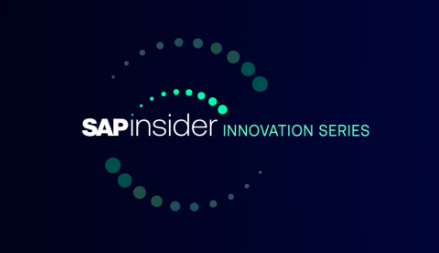Chevron and Deloitte Conquer the Art of the Possible
Meet the Authors
As companies make investments in technology, one of the primary objectives is to simplify the SAP landscape, while also ensuring visibility into business models and processes. Whether it’s moving to the cloud or SAP S/4HANA, standardizing the core system can help companies be more efficient and pivot quickly as market conditions evolve.
There is also a focus on using process automation intelligence to better serve employees and customers. “In this era of digital experiences where remote working, remote buying and remote partnerships are the norm, it’s really significant that you have a modern digital experience that is easy to navigate and speaks well for your organization’s reputation,” said Riz Ahmed, Chief Research Officer for SAPinsider.
With companies trying to drive innovation and change at a more rapid pace, technology is only half the solution. People are integral to those objectives as well. Merging IT and business for a more integrated organization that empowers business users and encourages innovation is critical.
Explore related questions
“Ultimately, it’s about putting a fence around these initiatives with the intent to accomplish them but in a way that manages risk and security — two areas at the forefront of many leaders and the source of what keeps them up at night,” Ahmed said.
These insights from Ahmed set the stage during January’s Executive Virtual Roundtable event “Pushing the Boundaries of Business Processes: From Customization and Standardization to Automation and the Art of the Possible.”
The event featured speakers Sarah Lottman, Senior Manager for Deloitte Consulting, and Mike Legaspi, IT Specialist and SAP Cloud Platform Architect for Chevron, and their collaboration to architect a framework that enabled Chevron to innovate and pivot quickly, while leveraging and pushing the boundaries of SAP’s Business Technology Platform (BTP).
A Process for NextGen Optimization
Chevron faced a dilemma: Leverage its next-gen technologies or become laggards in their industry. On the business side, it was unable to utilize new capabilities quickly and relied on IT for every issue. From an IT perspective, there was significant custom code not in use and minimal governance.
Legaspi and Lottman provided an overview of the project steps and areas of focus as Chevron underwent its digital transformation.
1) Gather business and IT feedback. The first thing Legaspi’s team did was gather feedback from the business and IT. The team learned there was a business need for a better user experience and self-service with less reliance on IT to make changes. For IT, it was reducing the amount of time installing upgrades and more time focused on next-gen initiatives and building better processes.
2) Institute governance structure. Once Deloitte was on the ground at Chevron, Lottman’s team defined the guiding principles for the end-to-end program. She said it was important to reiterate to the business and IT that the project was not simply a technical upgrade of SAP but rather a true digital transformation. Having a governance structure in place on day one was critical to minimizing customizations and achieve a clean core.
3) Review the platform and exercise standardization. Out of the box, understand SAP S/4HANA capabilities, said Legaspi. Because SAP S/4HANA is always evolving, he advised studying new capabilities a minimum of once per year. And due to the size of Chevron, IT had a significant number of customizations and extensions within SAP ERP Central Component. With SAP S/4HANA, Legaspi wanted to stay within the SAP standard of SAP S/4HANA.
4) Improve the user experience in SAP BTP. To maximize what SAP BTP can provide from a user experience perspective, Legaspi said the company is exploring a central Launchpad where anyone within the company, at any location has one access point for the app. There’s also a need for central messaging where business users have one dashboard within Launchpad.
5) Implement clean ERP. Having a clean ERP mindset means first identifying the problem statement. With new releases of SAP S/4HANA, there are major changes. Lottman pointed to SAP S/4HANA 2021 as having increased business process automation, more Fiori applications, and greater functionality Chevron can leverage. However, including a lot of customizations and enhancements within the core has an impact on upgrading quickly and on agility to adopt new technology.
What does Deloitte recommend? Lottman advised companies to use SAP BTP for their integrations, extensions, and workflows outside of the core SAP ERP. This allows for quicker adoption of new technology. And when evaluating customizations, examine how often they were executed over a 12-month period. It’s much easier to adhere to clean core principles with usage data as a guide for customization necessity.
6) Perform GAP Classifications. Lottman said GAP Classification was critical for identifying both regulatory and strategic extensions. The exercise involves identifying extensions that will be required to build. She said companies need to determine if there’s a regulatory need for the extension. If so, building that extension is necessary. Also, is an extension strategic? Does it help differentiate Chevron in the market? If the answer is yes, then the team resumes the business flow of that extension. Always review the SAP roadmap for what’s upcoming with SAP S/4HANA to ensure SAP’s future plans align with your GAP. Follow SAP’s extensibility guidelines when possible.
7) Make DevOps a focus in your program. Because Chevron had many customizations, DevOps was critical in determining how to manage those and how to automate code scannings to ensure quality code. Also, because the team was working with SAP S/4HANA at the core in addition to edge technologies using SAP BTP, DevOps helped the team marry up the dependencies as they deployed their objects up to production. The team utilized Azure DevOps connected to SAP BTP to automate code quality checks from an architect, which proved to save significant time.
Through these processes, Chevron went live last year with SAP S/4HANA for central finance and upgraded that instance to 2021 with minimal support. Improving the user experience with self-service reporting in central finance was a main benefit. Lottman says it proved that their strategy to limit customizations within the core was the right choice. SAP BTP was a major component of the strategy for central finance and remains a prevalent part of the larger digital transformation.
Lessons Learned
There were two critical lessons learned that Lottman and Legaspi cited from their SAP BTP project together. First, stay ahead of what SAP is working on with the next major release of SAP S/4HANA as well as the ever evolving and always changing SAP Business Technology Platform. This meant involving SAP in the journey early in the process. Chevron and Deloitte could better understand SAP’s cloud roadmap and the potential impact on how they would architect their solution.
Second, was setting up the governance process and remaining true to it. Most of the team members were new to SAP products and SAP S/4HANA. Thus, it was in their mindset to simply extend what the previous ERP offered. With a governance structure, it opened their minds to standard alternatives and not settle on the first idea.
Achieving a Mindset Change
There is often resistance to change from both the business and IT, said Legaspi. It could be the need for stability over innovation. However, by doing research, finding out what the team needs, and showing what the new products offer by creating a proof of concept, it can help steer the team toward agreement. But you have to listen first before moving to solutions.
Lottman added that gaining that mindset change also occurred because of work sessions where resources were pulled together, and the team walked through the art of the possible. Whether it was utilizing microservices or SAP BTP, IT got excited about the possibilities and was eager to jump in and get started.
Power of Change and Communication
Communication cannot be overstated in its ability to affect change. Lottman said on a regular basis there were regular architect meetings that included architects from SAP, Chevron, and Deloitte. It served as a forum for the architects to bring issues that could impact the program.
For example, the SAP BTP team constructed a proof of concept (POC) and provided a 5 to 10-minute demonstration whenever there was a new service or a new feature on an existing service (e.g., business rules and how they connect to Fiori apps).
Legaspi said each area provides a POC with a monthly or quarterly demo, demonstrating the agile processes that were in place. The POC was tested to see if it worked. If not, the team continued gathering feedback and reported the results to SAP.
This type of process is new, said Legaspi, especially collaborating closely with SAP and then informing the whole project team of what works and what is still under assessment. It requires constant communication and sharing.
Legaspi said the organization is invested in hearing even the minute details of each service because it helps drive innovation and discussion among the architects.






